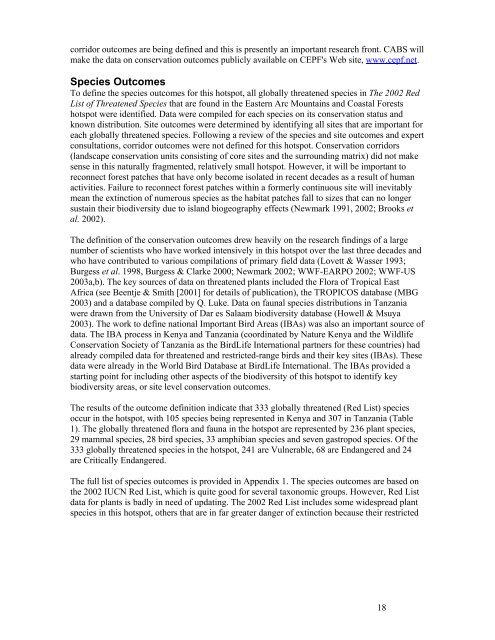Eastern Arc Mountains and Coastal Forests of Tanzania and Kenya ...
Eastern Arc Mountains and Coastal Forests of Tanzania and Kenya ...
Eastern Arc Mountains and Coastal Forests of Tanzania and Kenya ...
You also want an ePaper? Increase the reach of your titles
YUMPU automatically turns print PDFs into web optimized ePapers that Google loves.
corridor outcomes are being defined <strong>and</strong> this is presently an important research front. CABS willmake the data on conservation outcomes publicly available on CEPF's Web site, www.cepf.net.Species OutcomesTo define the species outcomes for this hotspot, all globally threatened species in The 2002 RedList <strong>of</strong> Threatened Species that are found in the <strong>Eastern</strong> <strong>Arc</strong> <strong>Mountains</strong> <strong>and</strong> <strong>Coastal</strong> <strong>Forests</strong>hotspot were identified. Data were compiled for each species on its conservation status <strong>and</strong>known distribution. Site outcomes were determined by identifying all sites that are important foreach globally threatened species. Following a review <strong>of</strong> the species <strong>and</strong> site outcomes <strong>and</strong> expertconsultations, corridor outcomes were not defined for this hotspot. Conservation corridors(l<strong>and</strong>scape conservation units consisting <strong>of</strong> core sites <strong>and</strong> the surrounding matrix) did not makesense in this naturally fragmented, relatively small hotspot. However, it will be important toreconnect forest patches that have only become isolated in recent decades as a result <strong>of</strong> humanactivities. Failure to reconnect forest patches within a formerly continuous site will inevitablymean the extinction <strong>of</strong> numerous species as the habitat patches fall to sizes that can no longersustain their biodiversity due to isl<strong>and</strong> biogeography effects (Newmark 1991, 2002; Brooks etal. 2002).The definition <strong>of</strong> the conservation outcomes drew heavily on the research findings <strong>of</strong> a largenumber <strong>of</strong> scientists who have worked intensively in this hotspot over the last three decades <strong>and</strong>who have contributed to various compilations <strong>of</strong> primary field data (Lovett & Wasser 1993;Burgess et al. 1998, Burgess & Clarke 2000; Newmark 2002; WWF-EARPO 2002; WWF-US2003a,b). The key sources <strong>of</strong> data on threatened plants included the Flora <strong>of</strong> Tropical EastAfrica (see Beentje & Smith [2001] for details <strong>of</strong> publication), the TROPICOS database (MBG2003) <strong>and</strong> a database compiled by Q. Luke. Data on faunal species distributions in <strong>Tanzania</strong>were drawn from the University <strong>of</strong> Dar es Salaam biodiversity database (Howell & Msuya2003). The work to define national Important Bird Areas (IBAs) was also an important source <strong>of</strong>data. The IBA process in <strong>Kenya</strong> <strong>and</strong> <strong>Tanzania</strong> (coordinated by Nature <strong>Kenya</strong> <strong>and</strong> the WildlifeConservation Society <strong>of</strong> <strong>Tanzania</strong> as the BirdLife International partners for these countries) hadalready compiled data for threatened <strong>and</strong> restricted-range birds <strong>and</strong> their key sites (IBAs). Thesedata were already in the World Bird Database at BirdLife International. The IBAs provided astarting point for including other aspects <strong>of</strong> the biodiversity <strong>of</strong> this hotspot to identify keybiodiversity areas, or site level conservation outcomes.The results <strong>of</strong> the outcome definition indicate that 333 globally threatened (Red List) speciesoccur in the hotspot, with 105 species being represented in <strong>Kenya</strong> <strong>and</strong> 307 in <strong>Tanzania</strong> (Table1). The globally threatened flora <strong>and</strong> fauna in the hotspot are represented by 236 plant species,29 mammal species, 28 bird species, 33 amphibian species <strong>and</strong> seven gastropod species. Of the333 globally threatened species in the hotspot, 241 are Vulnerable, 68 are Endangered <strong>and</strong> 24are Critically Endangered.The full list <strong>of</strong> species outcomes is provided in Appendix 1. The species outcomes are based onthe 2002 IUCN Red List, which is quite good for several taxonomic groups. However, Red Listdata for plants is badly in need <strong>of</strong> updating. The 2002 Red List includes some widespread plantspecies in this hotspot, others that are in far greater danger <strong>of</strong> extinction because their restricted18
















